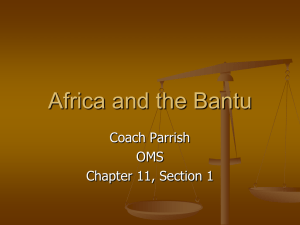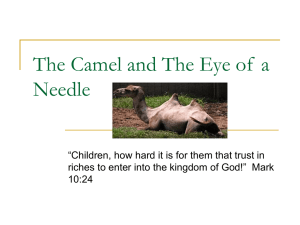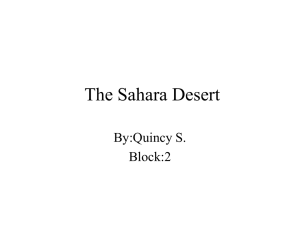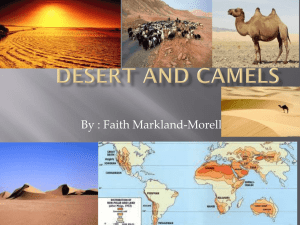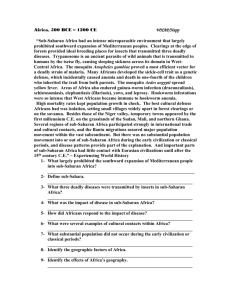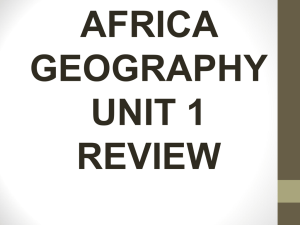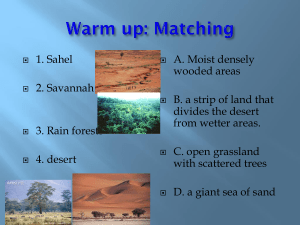Class Notes - Bantu Migration
advertisement
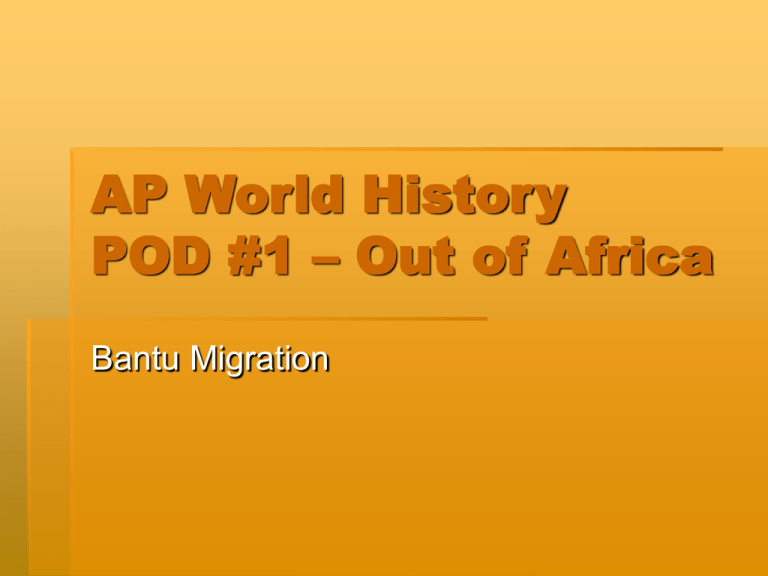
AP World History POD #1 – Out of Africa Bantu Migration Class Discussion Questions Bulliet et. al. – pp. 217-223 What is the geographic make up of northern (Saharan) Africa? The Sahara as we know it today dates to about 2500 B.C.E. The scarcity of water restricted travel to a few difficult routes by 300 B.C.E. Sprawling sand dunes, sandy plains and exposed rock are the main features of the desert Rugged mountains and highlands separate the northern and southern portions The earliest inhabitants hunted elephants, giraffes, rhinos, and crocodiles before the area dried out and the animals left the region These hunters were gradually joined by cattle breeders who could survive in the sparse grazing lands that remained What is the geographic make up of southern (Sub-Saharan) Africa? Located between the Sahara Desert, Atlantic Ocean, Indian Ocean and Red Sea Except for the Nile River the major river systems (Senegal, Niger, Zaire and Zambezi) were littered with rapids reducing their function for trade, transportation and travel In the 4000 mile journey from the Sahara south to the Cape of Good hope travelers would encounter the semi-arid steppes of the Sahel, a tropical savanna covered by long grasses and scattered forests through a tropical rain forest before re-encountering more steppes, deserts and temperate highlands Moving east to west across the continent (a distance roughly equivalent to that of the Silk Road) a traveler would face the challenges of equatorial (tropical) rainforests, mountains and deep rift valleys What theories exist to explain the establishment of Trans-Saharan Trade Routes? Mediterranean Charioteers drove across the desert establishing societies in the few remaining grassy areas in the central Saharan highlands Camel domestication and herding allowed for people to move away from the Saharan highlands and roam the deep desert How and Why did the camel become such an important element of the Trans-Sahara Trade Routes? With the development of the saddle the camel became a highly effective beast of burden across the desert as well as an important military weapon Southern Arabian Saddle – good for riding, allowed for loads to be tied to the wooden arches, inefficient for military applications because the rider knelt on a cushion behind the camel’s hump making it difficult to use weapons Northern Arabian Saddle – an improvement in saddle technology as the support arches still useful for carrying loads but were placed around the camel’s hump placing the rider on the top of the hump providing greater stability and height in battle Southern Sahara Saddle – designed only for personal and military use as there was no place to tie bundles What did the southern merchants have to offer in trade? Southern traders provided salt to the peoples of the sub-Saharan region Equatorial traders provided forest products (nuts and palm oil) to trading centers bordering the southern edge of the desert Sahel (coastal) traders provided agricultural products What did the northern merchants have to offer in trade? Roman colonists living in the Sahara region along the Mediterranean coast provided Italy with agricultural products (wheat and olives) How do anthropologist distinguish between “great traditions” and “small traditions”? Great Traditions – typically include a written language, common legal and belief systems, ethical codes, and other intellectual attitudes (loom large in written records) Small Traditions – comprised of the diversity of local customs and beliefs “By the year 1 C.E. sub-Saharan Africa had become a distinct cultural region, though not shaped by imperial conquest or characterized by a shared elite culture, a “great tradition.” The cultural unity of sub-Saharan Africa rested on similar characteristics shared to varying degrees by many popular cultures, or “small traditions.” (Bulliet, p. 215) What cultural uniformities can be found in Africa by 1 C.E.? Agriculture – technique of cultivation by hoe or digging stick Music – important role (especially drums) in social rituals, also important were dancing and wearing masks Kings were ritually isolated from the group Fixed social categories What theories are offered to explain the migration of people throughout Africa? As the north began to dry with the retreat of the Ice Aged glaciers around 5000 B.C.E migration to the south, east and west became more prevalent - This climate change and the movement east set the stage for the establishment of the Old Kingdom of Egypt around the Nile River Migrants with superior skills began to assert dominance over weaker pre-existing populations (recent research is beginning to refute this theory) What role did Iron play in the development of Africa? Iron smelting began in the northern subSaharan region in the early first millennium C.E. This technology spread south from there While the Hittites of Anatolia (Turkey) are credited with this discovery there is growing belief that the African’s discovered this for themselves while firing pottery Due to the location of the Proto-Bantu they are presumed to have played a significant role in the southward spread of iron What characteristics distinguish the Proto-Bantu? Bantu = people – comprised of over 300 language groups Lived in permanent settlements on the edge of the rainforest Cultivated the land (yams, grains, harvested palm nuts to press for oil) Domesticated animals (goats, dogs) Fished using canoes, nets, lines and hooks What characteristics distinguish the Bantu? The advance of the Bantu way of life established an economic foundation for new societies capable of sustaining a much larger population 500 B.C.E to 1000 C.E. saw a great influx of Bantu traditions to the south, east and west A new Pan-African culture was developing
